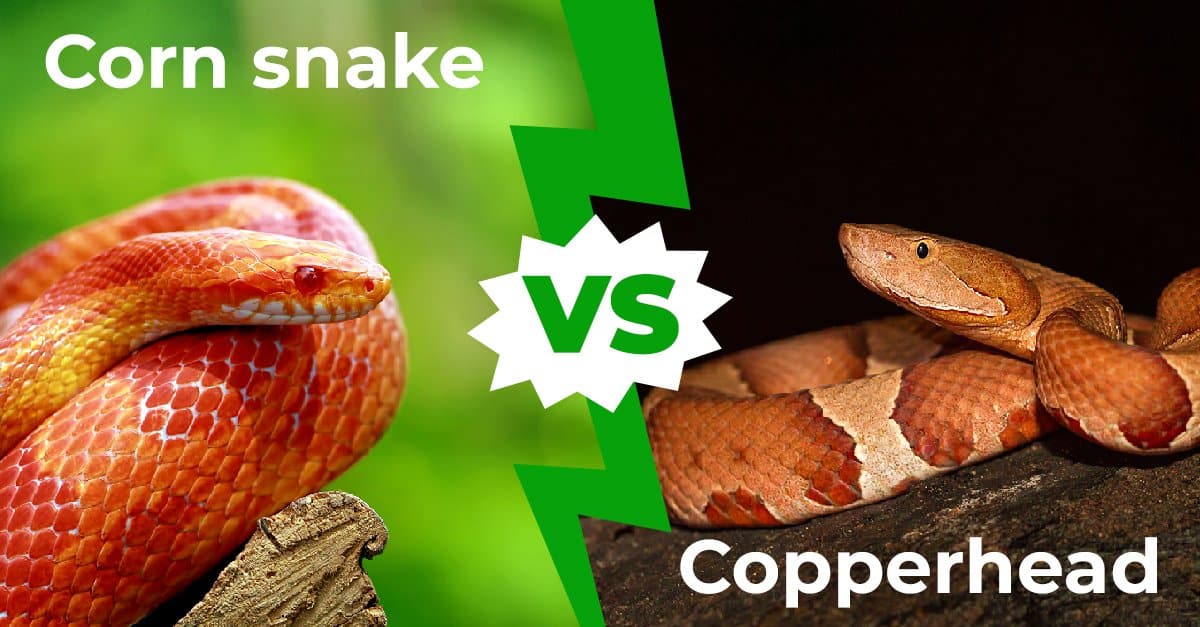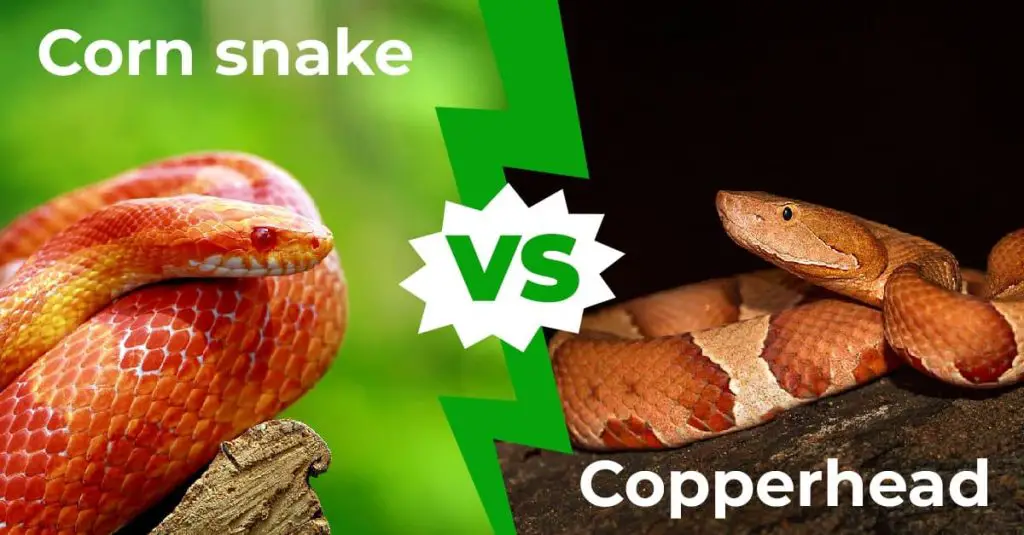When it comes to snakes, there are many types to choose from. But two of the most popular types of snakes are copperheads and corn snakes. While their names may sound similar, there are some distinct differences between them. In this article, we will explore these differences, from their appearance and habitats to their behavior and dietary habits. We will also look at how to identify each species so that you can choose the right pet snake for you.
| Copperhead | Corn Snake |
|---|---|
| Venomous | Non-venomous |
| Heavy-bodied | Light-bodied |
| Live in both woodlands and deserts | Live in grasslands, deserts, and forests |
| Bite is painful and can be fatal | Bite is harmless |
The main difference between copperheads and corn snakes is that copperheads are venomous while corn snakes are non-venomous. Copperheads have a heavy-bodied build and live in both woodlands and deserts, while corn snakes have a light-bodied build and live in grasslands, deserts, and forests. A copperhead bite is painful and can be fatal, while a corn snake bite is harmless.

Difference Between Copperhead And Corn Snake: In-Depth Comparison Chart
| Copperhead | Corn Snake |
|---|---|
| A venomous pit viper species found in North America | A non-venomous species of rat snake found in North America |
| Typically have a reddish-brown or tan body with darker crossbands | Typically have a red, orange, or yellow body with darker blotches |
| Head is distinctively triangular or “arrow-shaped” | Head is not distinctively triangular |
| Habitat includes woodlands, rocky hillsides, and swamplands | Habitat includes fields, forests, and woodlands |
| Can grow up to 3 feet in length | Can grow up to 4.5 feet in length |
| Adults have a single pair of chin shields | Adults have two pairs of chin shields |
| Ovoviviparous | Oviparous |
| Feeds on amphibians, reptiles, small mammals and birds | Feeds on small rodents, lizards and other snakes |
Difference Between Copperhead and Corn Snake
Copperhead and Corn Snakes are two species of snakes that are often confused with one another due to their similar color patterns. Copperheads are venomous, while Corn Snakes are non-venomous. The two snakes also differ in their size, behavior, diet, and habitat.
Appearance
The Copperhead and Corn Snake are easily distinguished by their physical appearance. Copperheads are usually a light brown or copper color, with darker hourglass-shaped markings. Corn Snakes, on the other hand, usually have a yellow or orange background color and black, red, or brown markings. Copperheads also have flat heads with wide, triangular-shaped pupils, while Corn Snakes have round pupils and more slender heads.
In terms of size, Copperheads are generally larger than Corn Snakes, growing to an average length of two to three feet. Corn Snakes, on the other hand, tend to be smaller, reaching an average length of two to four feet.
The two species also differ in their scales. Copperheads have a rough, keeled scale, while the scales of Corn Snakes are smooth and glossy.
Behavior
The behavior of Copperheads and Corn Snakes also differs. Copperheads are much more aggressive and will bite if provoked, while Corn Snakes are non-venomous and generally docile. Copperheads are also primarily active at night, while Corn Snakes are most active during the day.
In terms of diet, Copperheads feed on small mammals, birds, frogs, and insects. Corn Snakes, on the other hand, feed on small mammals, birds, lizards, and other snakes.
The two species also differ in terms of their habitat. Copperheads are found in forests, fields, and near streams and creeks. Corn Snakes, on the other hand, are found in forested areas, fields, and near streams and creeks, but they are also found in suburban and urban areas.
Venom
The most significant difference between Copperheads and Corn Snakes is their venom. Copperheads are venomous, while Corn Snakes are non-venomous. Copperheads’ venom is a neurotoxin that affects the nervous system and can cause paralysis, breathing problems, and even death. Corn Snakes, on the other hand, have no venom and are harmless to humans.
Reproduction
Copperheads and Corn Snakes also differ in their reproductive behavior. Copperheads lay eggs, while Corn Snakes give birth to live young. Copperheads lay up to 25 eggs at a time, while Corn Snakes give birth to up to 35 young.
Life Span
The two species also differ in terms of their life span. The average life span of a Copperhead is around 8 to 10 years, while the average life span of a Corn Snake is around 15 to 20 years.
Predators
The two species also differ in terms of their predators. Copperheads are preyed upon by large birds, snakes, and mammals, while Corn Snakes are preyed upon by larger snakes, birds, and mammals.
Habitat
Copperheads are typically found in forested areas, fields, and near streams and creeks. Corn Snakes, on the other hand, are found in forested areas, fields, and near streams and creeks, but they are also found in suburban and urban areas.
In terms of behavior, Copperheads are much more aggressive and will bite if provoked, while Corn Snakes are non-venomous and generally docile. Copperheads are also primarily active at night, while Corn Snakes are most active during the day.
Finally, Copperheads lay eggs, while Corn Snakes give birth to live young. Copperheads lay up to 25 eggs at a time, while Corn Snakes give birth to up to 35 young.
Difference Between Copperhead and Corn Snake Pros & Cons
Pros
- Copperhead snakes are better suited for more experienced owners due to their potential aggression.
- Copperhead snakes can live in a wider variety of climates than corn snakes.
- Copperhead snakes have more active lifestyles and are more likely to be seen moving around.
Cons
- Corn snakes are more docile and easier to handle than copperhead snakes.
- Corn snakes can live in a variety of temperatures, while copperhead snakes are more limited in their climate preference.
- Corn snakes are less active than copperhead snakes and tend to be more reclusive.
Difference Between Copperhead and Corn Snake
Copperhead snakes and corn snakes, while they may look similar, they have many differences. Copperhead snakes are more venomous, while corn snakes are more docile. Copperhead snakes are more aggressive, while corn snakes are more likely to avoid confrontation.
Copperhead snakes have a distinct pattern of darker brown and orange rings, while corn snakes have a more subtle pattern of light brown and yellow stripes. Copperhead snakes are typically found in the eastern and central United States, while corn snakes can be found throughout the United States.
When it comes to choosing between a copperhead and a corn snake, there are many factors to consider. Ultimately, it comes down to individual preference. Some people prefer copperhead snakes for their aggressive nature, while others prefer corn snakes for their docile nature. Here are 3 reasons to choose a corn snake as the final winner:
- Corn snakes are less venomous than copperhead snakes.
- Corn snakes are more docile and less likely to become aggressive.
- Corn snakes can be found throughout the United States.
In conclusion, the corn snake is the better choice for those looking for a less venomous, docile, and widely available snake.
Frequently Asked Questions About Difference Between Copperhead and Corn Snake
The copperhead and corn snake are two species of snakes that are among the most common in the United States. They have similar appearances but differ in their behavior, diet, and habitat. Knowing the difference between these two species can help you identify them and understand their behavior better.
What Are the Physical Differences Between Copperhead and Corn Snake?
The copperhead and corn snake have some similar physical characteristics, but there are also some differences. The copperhead has a reddish-brown head and a patterned body with a yellow-orange hue, while the corn snake has a plain, yellowish-brown body with dark brown blotches. The copperhead is typically between 2-3 feet in length while the corn snake can grow up to 4 feet.
What Are the Differences in Behavior Between Copperhead and Corn Snake?
The copperhead and corn snake have different behaviors. The copperhead is an ambush predator and will stay still, waiting for its prey to come close before attacking. The corn snake is a more active hunter and will actively search for prey. The copperhead is also more defensive than the corn snake, and will hiss and bite if it feels threatened.
What Are the Diet and Habitat Differences Between Copperhead and Corn Snake?
The copperhead and corn snake have different dietary and habitat preferences. The copperhead is an opportunistic feeder and will eat a variety of prey, including rodents, frogs, lizards, and insects. The corn snake prefers to eat small rodents, such as mice and voles. The copperhead can be found in a variety of habitats, including forests, swamps, and grasslands, while the corn snake prefers open areas, such as fields, meadows, and woodlands.
Do Copperhead and Corn Snake Lay Eggs?
Both the copperhead and the corn snake lay eggs. The copperhead lays its eggs in the summer months, and the eggs hatch after about two months. The corn snake lays its eggs in the late spring or early summer and they hatch after about two months.
Are Copperhead and Corn Snake Venomous?
The copperhead is considered to be a venomous snake, while the corn snake is not. The copperhead has a venomous bite that can cause swelling, pain, and even death if left untreated. The corn snake, on the other hand, does not have a venomous bite, and its bite is generally harmless to humans.
Corn snake vs Copperhead (identification)
In conclusion, it is evident that the Copperhead and Corn Snake are two distinct species of snake, each with its own unique characteristics. The Copperhead is a venomous snake native to the eastern United States, while the Corn Snake is a non-venomous snake found throughout the southeastern United States. While both snakes can be found in a variety of environments, the Copperhead prefers dry and rocky habitats, while the Corn Snake prefers moist and grassy areas. Furthermore, the Copperhead has a distinct pattern of crossbands, while the Corn Snake has a distinctive pattern of blotches that create a unique and beautiful design. Ultimately, while both species can be intimidating to humans, they are important to the environment and should be respected from a distance.


